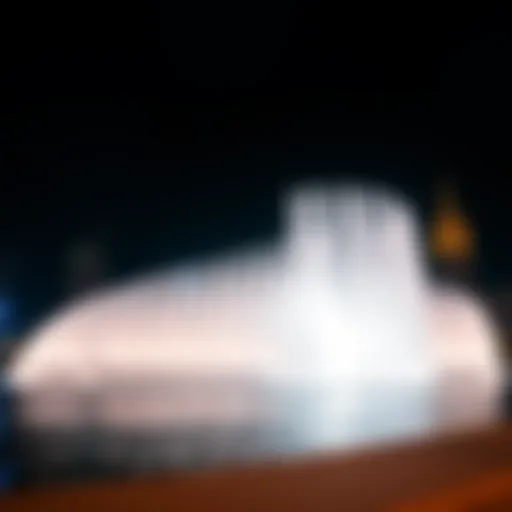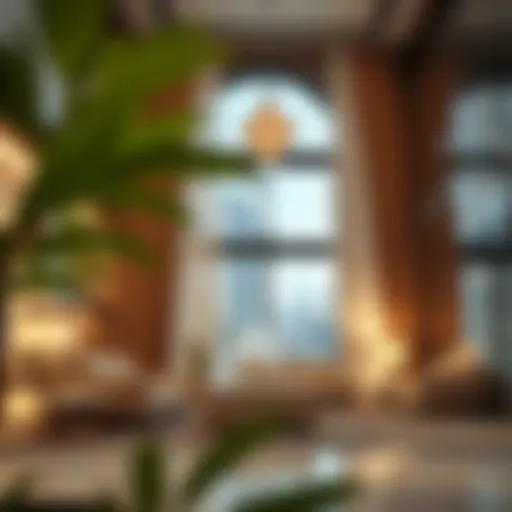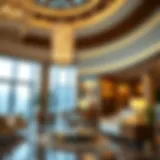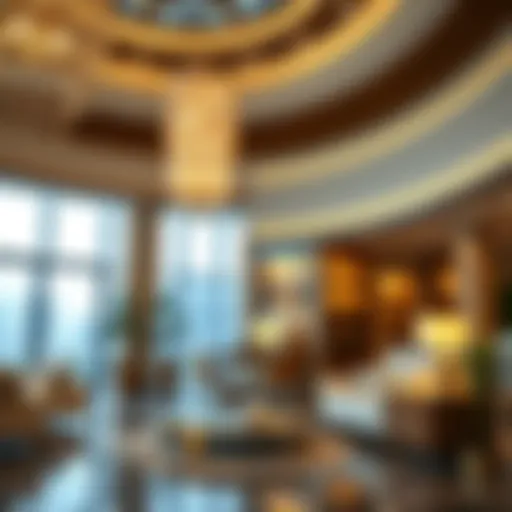Exploring the Financial Tower in Dubai


Intro
Situated against the backdrop of Dubai’s burgeoning skyline, the Financial Tower stands as a testament to the city's ambition and architectural innovation. Its sleek design and strategic location not only enhance the aesthetic landscape, but also play a pivotal role in the economic pulse of this ultra-modern metropolis. With the real estate sector witnessing a rapid transformation, the Financial Tower emerges as a focal point, attracting investors, expatriates, and homebuyers alike.
As we delve into the intricate fabric of the Financial Tower, it becomes crucial to understand the underlying currents of Dubai's real estate market. This exploration will unveil the tower's distinctive features and its broader implications on the local and global economy. Analyzing these elements provides invaluable insights into the dynamics of commerce and living in Dubai, positioning the Financial Tower as more than just a skyscraper, but as an integral part of a financial ecosystem.
Market Insights
Current Trends in Dubai Real Estate
Dubai’s real estate market is currently in a state of flux, reflecting both optimism and cautiousness among investors. The demand for commercial properties, particularly in prime areas, continues to escalate, driven by both local economic growth and foreign investments. As the city positions itself as a global financial hub, the Financial Tower is at the forefront of this emerging trend. The allure of high rental yields and favorable tax structures further entice investors, making it a hotspot for generating substantial returns.
Additionally, the ongoing infrastructure development, including new transport links and business districts, amplifies the appeal of areas surrounding the Financial Tower. The 2023 Expo has also ignited interest, highlighting Dubai’s readiness to welcome business ventures and expatriates.
Recent market analysis indicates an upward trend in property prices, drawing attention to the following key factors:
- A surge in expatriate arrivals, especially post-pandemic.
- Easing of visa regulations promoting long-term residency.
- Heightened demand for luxury and mixed-use developments.
Emerging Areas and Investment Hotspots
While traditionally, Dubai’s financial district has attracted significant investment, the landscape is shifting. Emerging areas nearby the Financial Tower are garnering attention from savvy investors:
- Dubai Creek Harbour: Promising mixed-use developments and unrivaled waterfront views.
- Downtown Dubai: Continues to be a pillar in luxury real estate trends but offers opportunities in high-rise residential segments.
- Dubai Marina: Tech-driven projects are enticing younger professionals, boosting rental demand.
Analyzing these emerging hotspots enables investors to identify opportunistic ventures and diversified portfolios that can withstand market fluctuations.
Buyer and Renter Guidance
Comprehensive Buying Process in Dubai
Navigating the buying landscape in Dubai requires a keen understanding of the processes involved. Firstly, potential buyers should familiarize themselves with the characteristics of freehold and leasehold properties. The Financial Tower is situated in a freehold area, offering foreign investors the capability to obtain full ownership.
The steps in the buying process typically include:
- Selecting a Property: Conduct thorough research and engage with local real estate agents for guidance.
- Due Diligence: Verify property titles, developer credibility, and site conditions.
- Sales Agreement: A legal document signed by both parties, outlining key details.
- Payment Transfer: Involves depositing a specified percentage of the property value, usually to a third party.
- Ownership Transfer: Finalizing ownership through the Dubai Land Department.
Essential Tips for Renters in Dubai
For those considering renting near the Financial Tower, it’s important to understand the local rental market. Here are some crucial tips:
- Understand the Lease Agreement: Familiarize yourself with the terms, especially regarding renewal and exit clauses.
- Know Your Rental Rights: The rental law in Dubai favors both landlords and tenants, so ensure you are aware of your rights.
- Explore Neighborhoods: Consider proximity to the Financial Tower, public transportation, and amenities.
- Use a Trusted Agent: A knowledgeable local agent can greatly simplify your search and negotiations.
Intro to the Financial Tower
The Financial Tower in Dubai stands as a pivotal marker in the city’s ambitious landscape. Situated in the heart of one of the world's most dynamic urban environments, it serves more than just a functional purpose. It is a beacon of Dubai's aspirations, shedding light on the convoluted relationship between architecture, business, and culture in this thriving metropolis. Understanding the contours of the Financial Tower is paramount for anyone looking to grasp the broader financial and social dynamics that define Dubai.
Overview of the Financial Tower
The Financial Tower is an architectural marvel that exemplifies the blend of modernity and tradition characterized by Dubai itself. Reaching skyward, the tower is not only visually striking but serves as a hub for finance and commerce. Built to accommodate a range of businesses, from multinational corporations to local start-ups, the tower fulfills its role as a commercial center by providing essential infrastructure and facilities.
The Financial Tower’s striking glass façade, reflective of Dubai's skyline, symbolizes transparency and innovation. This makes it more than just a place of work; it is a statement of what Dubai represents in the global market—an arena where the old and the new coexist seamlessly. For investors, expatriates, and other stakeholders, it offers both practical opportunities and a unique lifestyle in this modern oasis.
Historical Context and Development


To understand the significance of the Financial Tower, one must consider its origins and the context in which it was developed. Dubai, once a modest fishing village, evolved into a bustling trade and tourism hub. This transformation required infrastructure that could support its soaring ambitions. As Dubai positioned itself as a global financial nerve center, the construction of the Financial Tower became a crucial step.
The development of the Financial Tower was part of a broader vision laid out in Dubai's strategic plans in the 1990s, focusing on diversified economic growth and urban modernization. Official plans embraced a growing population and a booming economy, leading to a surge in real estate investments. This tower, completed in the early 2000s, was thus not merely a response to immediate needs; it reflected long-term aspirations to reshape the city’s identity into that of a global financial powerhouse.
The significance of the tower transcends its physical attributes; it embodies a shift in both economic and social dynamics. The area surrounding it has witnessed profound changes in demographics, residential demands, and business opportunities. With its development, the Financial Tower has catalyzed investment and interest in the surrounding quarters, further elevating Dubai's status on the world stage.
By comprehending these layers of history and development, stakeholders can appreciate the full impact of the Financial Tower on Dubai's architectural and economic landscape.
Architectural Features
The architectural features of the Financial Tower in Dubai not only define its aesthetic appeal but also highlight the underlying principles that guide its construction and purpose. These features play a crucial role in the overall significance of the tower within Dubai's urban landscape. They are a testament to innovative design, meticulous craftsmanship, and a commitment to sustainability. Each element converges to enhance not only the tower's functionality but also its influence on the economy and the urban dynamics of Dubai.
Design Philosophy
The design philosophy behind the Financial Tower is rooted in the idea of creating a space that is both functional and inspiring. The architects aimed to fuse modernity with elements that reflect the rich cultural heritage of Dubai. In doing so, the tower stands as a metaphorical bridge between tradition and contemporary advancements.
The use of sleek lines and glass facades contributes to its modern outlook, while interior designs often incorporate local motifs and art. A notable aspect of this design is its adaptability to cater to various business needs, ensuring that the tower remains relevant in a rapidly evolving market. Furthermore, the thoughtful layout and strategic placement of common areas encourage collaboration and networking among tenants, fostering an environment ripe for innovation.
Materials and Construction Techniques
The choice of materials and construction techniques is pivotal in the realization of the Financial Tower’s majestic presence. High-quality steel and reinforced concrete form the backbone of the structure, ensuring resilience against the elements and seismic activities. This choice not only bolsters the safety of the tower but also aligns with the architectural vision of standing tall and proud against Dubai’s skyline.
The exterior employs a curtain wall system that allows for abundant natural light to flood the interior spaces, reducing reliance on artificial lighting. This design decision highlights a growing trend in modern architecture to prioritize energy efficiency. Last but not least, the construction techniques utilized involved cutting-edge technology, which minimized waste and enhanced overall project efficiency. This forward-thinking approach signifies a shift towards more sustainable building practices.
Sustainability Considerations
In an era where environmental issues are at the forefront of global discourses, the Financial Tower has made significant strides towards sustainability. Its architects have integrated various green technologies that help reduce the building's carbon footprint. Energy-efficient systems, such as solar panels and smart water management, play a vital role in promoting sustainable practices.
Moreover, the landscaping surrounding the Financial Tower has been designed to promote biodiversity and provide green spaces, which are essential for enhancing the quality of life for its occupants. This focus on sustainability is not merely an afterthought; rather, it embodies an essential aspect of the tower’s identity. For instance, the incorporation of rainwater harvesting systems not only serves a practical purpose but also exemplifies a commitment to environmental stewardship.
The Financial Tower stands not merely as a structure of glass and concrete but as a beacon of sustainable innovation, reflecting Dubai's ethos as a global leader in eco-friendly urban development.
These architectural features work in concert to highlight not just the tower’s beauty but also its functionality and alignment with global standards of sustainability. Such insights provide potential investors and business owners with a clearer picture of what the Financial Tower represents in the ever-evolving business landscape of Dubai.
Economic Impact
The Financial Tower stands as a beacon of economic prowess in Dubai, serving not only as a physical structure but also as a pivotal contributor to the local economy and an attractive proposition for international investors. In a city renowned for its transformative growth and ambitious urban landscape, this tower exemplifies the intricate interplay between architecture and economics. Understanding the economic impact of the Financial Tower reveals how it shapes the broader financial ecosystem and enhances Dubai's stature on the global stage.
Contribution to Local Economy
The Financial Tower's role in fortifying the local economy is multifaceted. By housing various businesses and corporations, it generates significant employment opportunities. This influx of jobs provides a vital boost to the local populace, supporting families and enabling a steady flow of income. The tower attracts both skilled professionals and support staff, stimulating sectors such as hospitality, retail, and transportation.
Moreover, the construction of such a monumental building necessitated substantial investment in local resources and labor. This infuse of capital circulates through the community, benefitting suppliers, contractors, and service providers. Additionally, local small businesses often thrive due to the patronage from tower employees and visitors, creating a ripple effect of economic activity.
"The true worth of a structure lies not just in its physical form, but in the opportunity it creates for those who inhabit it."
The presence of the Financial Tower also enhances property values in the surrounding area. Properties situated nearby gain premium pricing due to their proximity to a major business hub. This boost in property values contributes positively to the local economy, benefitting homeowners and investors alike.
Attracting International Investment
The Financial Tower serves as a crucial magnet for international investment. Its architectural allure and modern amenities position it as an ideal choice for multinational corporations looking to establish a regional presence. As these firms set up shop within the tower, they invariably draw attention to Dubai as a prime investment destination.
Prospective investors recognize the significance of the Financial Tower as not just a building, but a strategic hub for various industries. This perception encourages foreign direct investment (FDI), as investors seek to take advantage of Dubai's favorable business climate, robust infrastructure, and strategic geographical location. The tower’s ability to attract companies leads to an influx of capital, bolstering the local economy and reinforcing Dubai’s reputation as a global financial center.
In summary, the Financial Tower's economic impact transcends mere aesthetics; it is a cornerstone of Dubai's growing economy. Through its contribution to local employment, improvements in property values, and its role as an attraction for international investment, the Financial Tower solidifies Dubai's place in the world economy.


Investment Opportunities
Investment opportunities surrounding the Financial Tower in Dubai are not merely about buying square footage; they represent a gateway to a booming economic hub that continues to attract a diverse pool of investors. As a landmark in a city that prides itself on innovation and ambition, the tower offers unique prospects for those looking to capitalize on both residential and commercial ventures.
Residential vs. Commercial Spaces
When considering investment within the Financial Tower, one can distinguish between residential spaces and commercial offices, each catering to different clientele, needs, and potential returns.
- Residential spaces within the tower often appeal to expatriates and professionals seeking proximity to Dubai's bustling business districts. The allure lies in modern amenities, convenience, and a vibrant community atmosphere—factors that can drive up demand. Moreover, the tower's design embraces a lifestyle that combines comfort with accessibility, making it an attractive option for investors looking to rent out either short- or long-term.
- Commercial spaces, on the other hand, present substantial prospects for businesses wanting to establish themselves at a prime location. The tower's strategic position enhances visibility, helping businesses thrive through increased foot traffic. Leasing offices comes with the added benefit of a dedicated business ecosystem that encourages networking and collaboration among tenants.
Investors considering their strategy must weigh the pros and cons of both space types based on market demands and future trends in Dubai’s real estate scenery.
Leasing Potential
Leasing potential in the Financial Tower seems promising, especially as demand outpaces supply in key areas of Dubai. With businesses vying for a foothold in the city's commercial landscape, commercial spaces can attract lucrative leases. This is particularly true for startups and established enterprises looking for a prestigious address that helps them stand out. Additionally, residential units enjoy steady interest from expatriates and young professionals who often seek out places that offer a quick commute to their workplaces.
- Residential Investors can expect rental yields that are favourable, primarily due to the tower's appeal to those who prefer a bustling city lifestyle.
- Commercial Investors may tap into an increasing desire among international firms to establish a presence in Dubai, creating a steady revenue stream. This area is not just about square footage; it is about cultivating connections and building a brand in a city on the rise.
Market Trends and Projections
As Dubai continually evolves, potential investors should keep a close eye on prevailing market trends. Analyzing historical data, competition, and the overall economic trajectory of Dubai sheds light on where investments might yield the best returns. Factors such as the type of industries moving into the area, infrastructure development, and demographic shifts all play crucial roles.
It is essential for potential investors to consider:
- The rise of fintech and tech-related enterprises.
- The increasing number of expatriates moving to Dubai seeking professional opportunities.
- Government initiatives encouraging investment in real estate.
As per analysts, the sectors have shown steady growth, hinting that investments made today may not only provide immediate returns but contribute to long-term wealth creation. The Financial Tower represents more than simple blocks of concrete; it symbolizes a hub of opportunity for those ready to take the plunge into Dubai’s lucrative real estate market.
"Investing in the Financial Tower is akin to placing a bet on Dubai's progress; the odds continue to improve as the city evolves into a global business center."
Cultural and Social Influence
The Financial Tower in Dubai represents far more than just a collection of concrete and glass. Its presence weaves into the social fabric of the city, holding significance that stretches beyond mere functionality. This section unpacks how the tower integrates with the urban landscape and its ripple effects on lifestyle and work patterns.
Integration into Urban Landscape
The Financial Tower stands tall amongst other modern edifices in Dubai's bustling cityscape. Its strategic location and stunning architectural design enhance its visibility and prominence. This prominence is not only about height; it's about creating a sense of identity for the area. The surrounding developments, such as parks and cultural venues, establish an environment that encourages both work and leisure.
A notable aspect of this integration is how it fits within the urban planning framework of Dubai. The city's developers have shown a commitment to creating spaces that enhance public interaction. The area around the tower features pedestrian walkways and open spaces, inviting residents and visitors to engage with their surroundings. For expatriates and locals alike, this becomes more than a place to work; it’s a social hub where business meets community.
Aside from the physical space, the Financial Tower acts as a catalyst for change in the surrounding environment. For instance, many new businesses have emerged nearby, offering diverse services that cater to the influx of professionals seeking employment in the tower. This has not only enhanced the local economy but has also fostered a vibrant community atmosphere, which is vital in keeping the spirit of Dubai alive.
Influencing Lifestyle and Work Patterns
The emergence of the Financial Tower has also induced shifts in how people view work-life balance in Dubai. With modern amenities and state-of-the-art facilities, the tower has shaped expectations around professional environments. No longer is it just about having a desk; it’s about experience. Open office layouts, collaborative spaces, and wellness areas transform traditional work settings into more inviting places.
Moreover, businesses housed within the tower often promote flexible working hours and remote work options. This flexibility helps professionals manage their time efficiently, contributing to a lifestyle where work doesn’t dominate personal life.
The design of the tower incorporates leisure spaces that encourage relaxation and social interaction, ultimately playing a pivotal role in influencing daily routines. Employers recognize that when employees feel connected to their workspace, productivity often improves. This change ripples through the workforce, resonating strongly with expatriates who may seek such opportunities in an otherwise competitive market.
"The Financial Tower symbolizes more than its structure; it signifies the modern ethos of Dubai's workforce, reshaping how we perceive our daily lives."
In conjunction with the tower’s broad reach into social dynamics, understanding its influence helps potential investors and homebuyers navigate the evolving landscape of Dubai’s real estate market.
The Role of the Financial Tower in Dubai's Identity


The Financial Tower stands not just as an architectural marvel, but it also embodies the aspirations of Dubai to carve out a significant niche on the global financial stage. This structure encapsulates a blend of innovation, ambition, and the relentless spirit of a city that continually seeks to redefine itself. By examining the symbols associated with the Financial Tower, and how it affects the tourism landscape, we can uncover the depth of its contribution to Dubai's identity.
Symbol of Modern Dubai
The Financial Tower has become a beacon of modernity, representing the city’s transformation from a modest trading post to a global financial powerhouse. Its impressive height and striking architecture contribute to the skyline that distinguishes Dubai from other economic hubs.
Visitors and residents alike often remark that the tower serves as a testament to Dubai's forward-thinking mentality. With its glassy facade reflecting not only sunlight but also the ambition that drives the city, this iconic structure has become synonymous with Dubai’s identity. It is a physical representation of growth, innovation, and resilience.
Key Elements of the Tower as a Symbol:
- Architectural Brilliance: The unique design mimics the flow of trade and finance, resembling an arrow aiming upwards toward success.
- Cultural Significance: The tower illustrates a blend of local culture and global influences, showcasing how Dubai embraces diversity while still honoring its roots.
- Economic Hub: Often referred to as the nucleus of activity for local and international businesses, it plays a critical role in enhancing Dubai's status as a business-friendly city.
In many ways, the Financial Tower acts as a symbol of hope and opportunity. It invites investors worldwide, and for many expatriates, it becomes a familiar landmark, representing their dreams and ambitions in the UAE. Its presence reinforces an image of a vibrant economy ready to embrace challenges head-on.
Impact on Tourism
The role of the Financial Tower in harnessing Dubai's tourism potential cannot be overstated. Tourists flock to see its grandeur, and it often features prominently in promotional materials that highlight the essence of the city. The tower's strategic location enhances its appeal, drawing visitors not only for its visual allure but also for its proximity to other notable landmarks.
Ways the Tower Influences Tourism:
- Urban Tours: The structure is frequently included in guided tours showcasing Dubai's architectural wonders. Tourists want to snap a photo with it in the background, making it a staple in tourist itineraries.
- Cultural Events: Various events and exhibitions hosted in or near the Financial Tower attract visitors, effectively enhancing foot traffic and revenue for local businesses.
- Luxury Accommodations: The area around the tower is home to high-end hotels and shopping, catering to tourists seeking premium experiences during their stay.
Future Prospects
The Future Prospects of the Financial Tower in Dubai mark a pivotal point in understanding how this remarkable structure will shape not only the skyline but the wider urban landscape. As the heartbeat of Dubai's financial activities, the potential for growth and innovation around this tower provides investors and stakeholders with essential insights into what lies ahead. The plans for urbanization and real estate development pivot around the strategic positioning of the tower, ultimately influencing economic mobility and lifestyle in the region.
Urban Development Plans
The urban development plans surrounding the Financial Tower showcase an ambitious blueprint to expand Dubai's influence as a global financial hub. These plans aim to create an ecosystem that fosters business growth, promotes tourism, and enhances the quality of life for residents. Some notable aspects include:
- Integration of Mixed-Use Developments: Future projects will likely include a mix of residential, commercial, and recreational areas. This means not just office spaces but also cafés, boutiques, and parks—all designed for synergy and convenience.
- Transportation Enhancements: Improving accessibility is crucial. Enhancements to public transport, like expanding the Dubai Metro and introducing dedicated bus routes, are likely to occur, making it easier for people to move in and out of the financial district.
- Smart City Initiatives: There is a strong push towards incorporating smart technologies into urban planning. This includes climate-responsive energy solutions, smart traffic management systems, and enhanced connectivity through high-speed internet, furthering the growth of tech-driven businesses.
"The Financial Tower is not just a standalone icon; it represents the connective tissue of the future Dubai economy, stitching together innovation, lifestyle, and global engagement."
By melding these elements together, the urban development plan aims to ensure that the Financial Tower remains relevant and central to Dubai's evolving narrative.
Potential Challenges
Despite the optimistic outlook, there are also key challenges that stakeholders must navigate. Addressing these head-on will be vital to ensure sustainable progress:
- Market Volatility: Economic fluctuations in the region, exacerbated by global downturns, can impact leasing rates and property values. Investors must stay vigilant, carefully analyzing market conditions before making significant commitments.
- Sustainability Concerns: The rapid urban development may pose environmental challenges. Balancing the desire for technological advancement with ecological preservation is paramount. Ensuring that projects meet sustainability standards will require continuous oversight and innovation in construction practices.
- Regulatory Hurdles: Changes in government policies and regulations can dramatically affect real estate relations. Stakeholders need to be prepared for policy shifts that might impact foreign investments, zoning laws, and taxation.
Closure
The conclusion part of this article serves to pull together the various threads discussed throughout. It is a critical section, as it highlights not only the findings related to the Financial Tower in Dubai but also places them in a broader context of urban development and economic growth within the emirate. By delivering a clear summation, readers can grasp the essential insights and implications that shape their understanding of current trends and future possibilities.
Summation of Key Insights
As we reflect on the elements explored, several key insights emerge regarding the Financial Tower:
- Architectural Significance: The tower is not just a building; it epitomizes modern design and urban innovation.
- Economic Contributions: It plays a pivotal role in the economic landscape of Dubai, enhancing local business operations and attracting international investors.
- Sociocultural Impact: The Financial Tower has influenced the lifestyle and work patterns of many, becoming a centerpiece around which commerce thrives.
- Investment Opportunities: Both residential and commercial spaces within the tower offer a feast for investors, showing promising returns aligned with global trends.
Each point underlines a piece of the puzzle that makes the Financial Tower a landmark in Dubai. Its implications reach beyond concrete and glass, touching realms of finance, design, and community structure.
Final Thoughts on the Financial Tower's Role
The Financial Tower stands tall not only as an architectural feat but also as a symbol of what Dubai aspires to be: a global financial hub. Its future will hinge on various factors, and it must navigate challenges like global economic fluctuations and shifts in real estate demand.
Furthermore, as the city continues to grow and evolve, the Financial Tower will likely adapt to meet the demands of a more diverse population, showcasing the dynamic nature of Dubai itself. Investors, expatriates, and homebuyers must keep a keen eye on its developments, as they reflect the shifting tides of the market and the broader implications for urban living and working.
Ultimately, the Financial Tower is more than just a landmark; it represents a vision of progress and prosperity that resonates across borders and cultures, making it a focal point for anyone interested in the future of Dubai's economic landscape.















